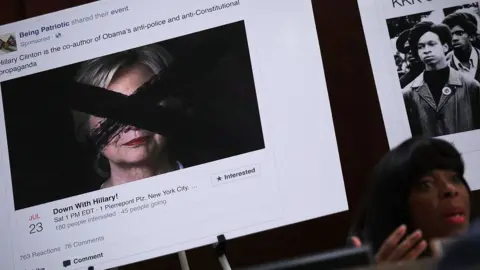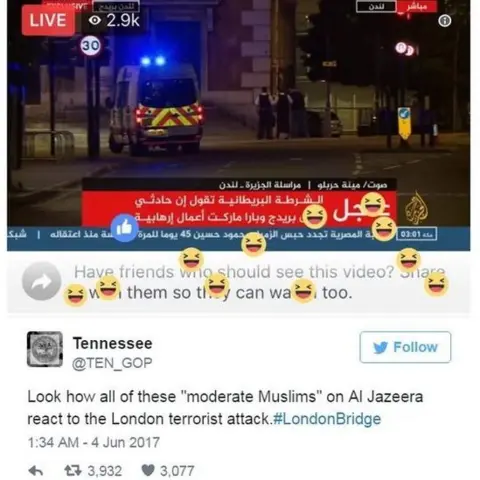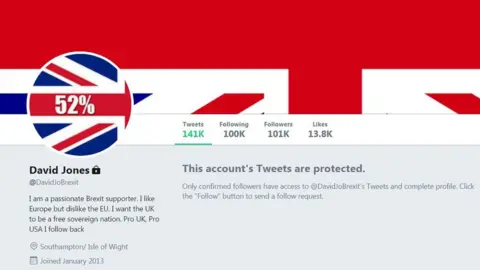How Russian bots appear in your timeline
 Getty Images
Getty ImagesPrime Minister Theresa May has accused Russia of "planting fake stories" online as part of a "campaign of cyber-espionage and disruption".
Her comments come after prominent social media accounts were exposed as Russian bots.
At the start of November, the US Senate Select Committee on Intelligence provided a list of 2,753 suspended, Russian-linked Twitter accounts.
But who is behind these bots and how do they operate?
Many bot accounts have been traced to the Internet Research Agency, in St Petersburg. The Russian government-backed agency reportedly runs social media accounts disseminating "disinformation".
This "troll farm" was exposed by a whistleblower in the New York Times in 2015. A BBC investigation has also uncovered a pro-Russia "troll factory" in Ukraine.
The Oxford Internet Institute - part of the University of Oxford and recipients of the Democracy award for its analysis of propaganda - says bots "significantly impact [on]public life during important policy debates, elections, and political crises" and "flourished during the 2016 US presidential election".

Bot-spotting tips
The Atlantic Council's Digital Forensic Research Lab (DFRL) offers social-media users tips for spotting a bot:
- Frequency: Bots are prolific posters. The more frequently they post, the more caution should be shown. The DFRL classifies 72 posts a day as suspicious, and more than 144 per day as highly suspicious.
- Anonymity: Bots often lack any personal information. The accounts often have generic profile pictures and political slogans as "bios".
- Amplification: A bot's timeline will often consist of re-tweets and verbatim quotes, with few posts containing original wording.
- Common content: Networks of bots can be identified if multiple profiles tweet the same content almost simultaneously.
The Digital Forensic Research Lab's full list of tips can be found here.

There has been a move away from fully automated bots to semi-automated accounts.
Such accounts are harder to identify, as they intersperse their activity with references to popular culture and personalised replies.
@SouthLoneStar
After the Westminster Bridge terrorist attack in March 2017, Twitter user @SouthLoneStar - who described themselves as "Proud TEXAN and AMERICAN patriot" - posted an image of a young woman in a headscarf on the bridge in the immediate aftermath of the attack.
 REX/Shutterstock
REX/ShutterstockThe user captioned the photograph: "Muslim woman pays no mind to the terror attack, casually walks by a dying man while checking phone #PrayForLondon #Westminster #BanIslam".
The tweet attracted a lot of attention at the time and was widely shared, prompting many inflammatory comments.
Although the account had more than 16,500 followers on Twitter, it was suspended after being identified as a Russian bot.
The unnamed woman in the photograph released a statement through the organisation Tell MAMA (Measuring Anti-Muslim Attacks).
"I'm shocked and totally dismayed at how a picture of me is being circulated on social media," she said.
"Not only have I been devastated by witnessing the aftermath of a shocking and numbing terror attack, I've also had to deal with the shock of finding my picture plastered all over social media by those who could not look beyond my attire, who draw conclusions based on hate and xenophobia."
@TEN_GOP
 Twitter/@TEN_GOP
Twitter/@TEN_GOPThe Twitter user @TEN_GOP posted a digitally altered image of "moderate Muslims" reacting to the news of the London Bridge attack on a Facebook Live stream from the Al Jazeera news network.
The BBC debunked the fake image shortly after it surfaced, and the account - which had more than 136,000 followers - was suspended by Twitter in August.
The account was not affiliated to the official Tennessee Republican Party and this week the Senate Select Committee on Intelligence confirmed @TEN_GOP was a Kremlin-linked bot.
 @TEN_GOP/Twitter
@TEN_GOP/Twitter@DavidJoBrexit
 @DavidJoBrexit/Twitter
@DavidJoBrexit/TwitterWhile not confirmed, there are accusations @DavidJoBrexit is a Russian bot posting pro-Brexit and anti-immigration content to its more than 100,000 followers.
The Times reported the account was a "Russian stooge", citing the activity of the account and analysis by Twitter user @conspirator0.
Allow X content?
@DavidJoBrexit account was set up on 27 January 2013 - over 1,750 days ago. As such, this account has posted, on average, more than 80 times a day.
Allow X content?
The account Tweeted any accusations it was a bot were "completely defamatory", adding: "I am not pro-Kremlin at all, I am just a Brexit supporter."
The account was set to private following the Times article.
